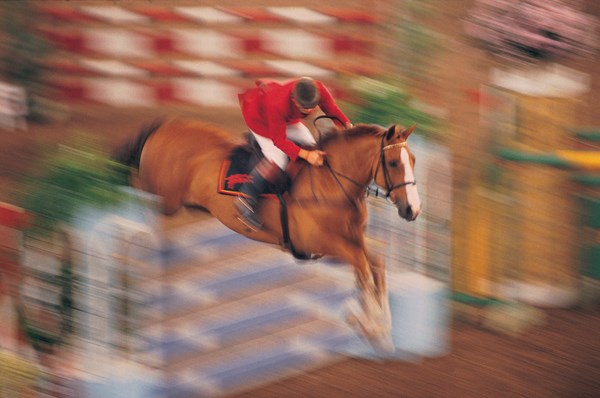 Credit: Thinkstock Low NSC concentrates may not provide enough substrate for glycogen repletion following multiple bouts of intense exercise.
Credit: Thinkstock Low NSC concentrates may not provide enough substrate for glycogen repletion following multiple bouts of intense exercise.Muscle glycogen is a potentially limiting substrate for horses during intense exercise. Low-starch, high-fat concentrates have become popular for performance horses, but their effect on muscle glycogen usage and repletion is unclear. This study was conducted to evaluate the effect of nonstructural carbohydrate (NSC) intake on substrate utilization and glycogen repletion in Thoroughbreds during training and following multiple bouts of intense exercise.
Six fit Thoroughbred geldings (BW 555.2 ± 29.9 kg) aged 8.2 ± 0.9 years were used in a replicated 3×3 Latin square design. Horses were fed isocaloric, isonitrogenous rations that supplied high (HS), medium (MS), or low (LS) NSC intake. The horses were fed 1.25% BW/d grass hay and 1.0% BW/d concentrate. The HS concentrate consisted of oats, corn, and molasses. The MS concentrate was a pelleted mix of dehydrated corn germ meal (Golden Max) and alfalfa meal. The LS concentrate contained wheat middlings, soy hulls, vegetable oil, and beet pulp. The HS, MS, and LS concentrates contained 65.2, 46.5, and 12.3% NSC and 4.8, 7.8, and 14.3% fat (DM basis), respectively. These rations provided 45, 36, and 18% of total digestible energy (DE) from NSC; 11, 15, and 23% of total DE from fat; and 30, 33, and 45% of total DE from fiber.
During each 1-month period, horses were trained for three weeks on a high-speed treadmill followed by a 3 day glycogen-depletion period. On Day 1 of the glycogen-depletion period, horses performed an incremental exercise test (IET) on an inclined treadmill (at 3 degrees), consisting of 5 minutes walk, 2 minutes at 4, 6, and 8 meters/second, and 1 minute at 9, 10, 11, 12, and 13 meters/second. On Days 2 and 3 of the depletion protocol, horses performed an interval-training exercise bout consisting of four series of 5-minute trot (4 meters/second) alternated with 2-minute gallop (10 meters/second), and a cooling-off period of 5-minute trot (4 meters/second) and 5-minute walk. Muscle biopsies were taken before and 0, 24, 48, and 72 hours post-depletion.
One horse suffered a rhabdomyolysis episode during period 1 and was removed from the trial. All data reported are from the five remaining horses. During the IET, lactate was lower in LS compared to MS or HS (P < 0.05). Heart rate, plasma glucose, VO2, and VCO2 were unaffected by treatment. Muscle glycogen depletion averaged 33, 30, and 36% in the HS, MS, and LS treatments. At 72 hours, muscle glycogen average 94, 94, and 63% of pre-depletion levels in the HS, MS, and LS treatments, respectively. Muscle glycogen repletion was lower in the LS group 72 hours post-depletion (P < 0.05).
Low NSC concentrates may not provide enough substrate for glycogen repletion following multiple bouts of intense exercise.
This report of KER’s research was published in Proceedings of the 2015 Equine Science Society Symposium.
Read the entire research paper, titled Effect of Nonstructural Carbohydrate Intake on Glycogen Repletion Following Intense Exercise.
Visit equinews.com/newsletters to subscribe to The Weekly Feed, KER’s award-winning equine nutrition newsletter.


